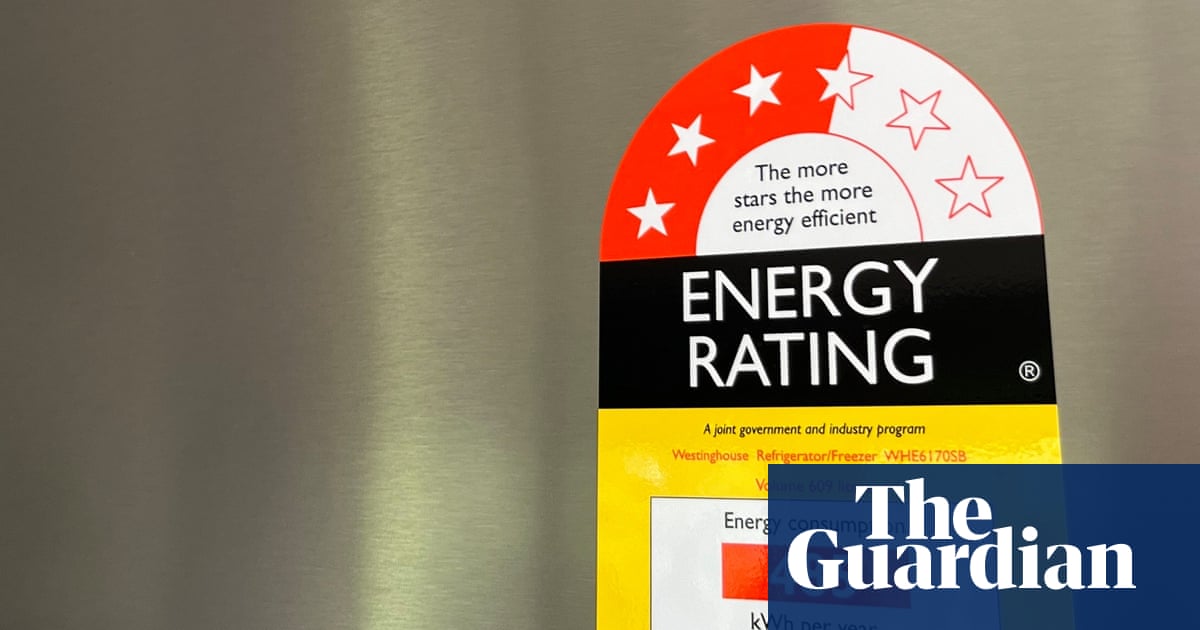Australian households and businesses are missing out on billions of dollars of power bill savings, an expert has warned, after a scathing audit found the department in charge of the efficiency scheme for appliances has failed to properly administer it.
The poor administration of the program has left consumers worse off, saidAlan Pears, a senior fellow at RMIT and Melbourne University, who helped develop appliance energy standards in Victoria.
Pears warned the program needs a wider rethink, including strengthening “weak” minimum standards which are preventing people getting access to or buying the most efficient appliances, leading to higher energy bills.
Sign up for Guardian Australia’s breaking news email
The Greenhouse andEnergyMinimum Standards (Gems) Act ensures products meet minimum energy performance standards and energy rating label requirements. The labelling requirement includes the energy efficiency star-rating stickers often seen on refrigerators or dishwashers.
But the National Audit Office (ANAO) report found the Department of Climate Change, Energy, the Environment and Water is not measuring the program’s impact on reducing emissions. The report said the department “is not measuring the program’s impact on reducing energy consumption and carbon emissions and so cannot demonstrate whether the program is achieving its intended purpose”.
Issues flagged in the ANAO report and could negatively impact its credibility, Pears said.
Pears said the energy rating stickers “have a lot of credibility with people” and is “relied upon” by consumers.
“The issue we face now is, if the program is not being properly administered – and clearly it hasn’t been – then the government and the energy sector too are at risk of … losing credibility with consumers.”
The department has said the scheme has saved households and businesses between $12bn and $18bn in energy costs since the Act was legislated in 2012. Between 2021 and 2022, it said consumers saved between $1.3bn to $2bn, and greenhouse gas emissions were reduced between 4.1m and 6.3m tonnes.
But Pears said the broad gap in estimated figures suggests the scheme isn’t working as intended.
“The fact that there’s such a wide band reflects the fact that they have some idea but not a very precise idea of what the benefits are,” he said.
Pears said that beyond the administrative gaps, the current minimum standards are “weak” compared to best-practice regions like the European Union or China.
For example, the EU began enforcing a new rule this year for the energy consumption of electrical appliances in standby or off-mode, which it says will save consumers up to $950m between now and 2030.
If Australia were to raise its standards, Pears said every household or business could save “thousands” of dollars over the lifetime of each appliance.
“Because our standards are quite weak, we don’t necessarily get the most efficient products,” Pears said.
Under the legislation, companies test their appliances in approved laboratories according to the minimum standards. Thedata is sent to the climate change department for review. If compliant, the appliance is approved for sale in Australia.
The department can perform a “check test” on products to independently to ensure they are compliant.
The audit said the number of check tests has been decreasing over recent years, and haven’t targeted areas with the “greatest risk of non-compliance”. In the financial year 2013-2014 the department conducted 188 check tests, according to the ANAO, but in 2021-22 just 61 models were checked.
The department told the ANAO it aims to test between 60 and 70 products annually.
Sign up toBreaking News Australia
Get the most important news as it breaks
after newsletter promotion
Pears said this can allow some bad actors to get away with subpar testing.
Pears said an effective testing program is similar to speed cameras on the road.
“If you think you might get caught for speeding, you’ll obey the speed limit. With any regulatory system like appliance efficiency, if you think you might be caught, you’re much more likely to do things properly.”
Since the program was established in 2012, the department has issued just four infringement notices, none which were paid or enforced. The audit office report said this could “limit the department’s ability to effectively encourage compliance and deter non-compliance”.
ANAO’s report also found that, in many cases, the same person within the climate change department was in charge of assessing and approving or rejecting a product.
“Without effective segregation of duties, there is risk that products that do not meet the requirements of the relevant Gems determination may be approved for registration. This also increases the risk of human error or corruption,” the report said.
Pears also believed information on appliance efficiency stickers should be improved. He wants the government to spend more money to improve consumers’ understanding of the rating system, and ensure the system is fit for purpose.
“You have to be careful because the star rating is based on the size of the appliance, not necessarily on its actual energy use. So if you’ve got a seven-star enormous television, that can still be using a lot more energy than a much smaller TV that’s got a low star rating.”
The department responded to the audit, accepting all of its nine recommendations, and said work is already under way to improve the program.
ANAO recommended check testing be targeted to areas with the greatest risk of non-compliance. It also recommended the department develop performance measures to assess the effectiveness of the program in achieving its outcomes.
In a statement, the department confirmed it has established a taskforce to improve the program, and has begun “expanding the availability of check facilities” to encourage better compliance.
